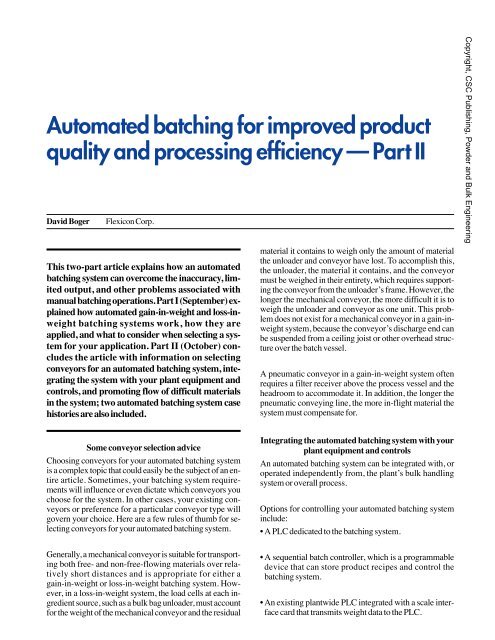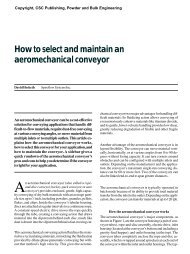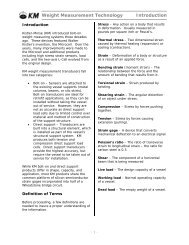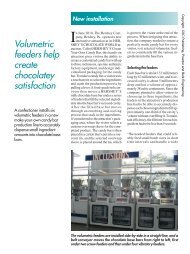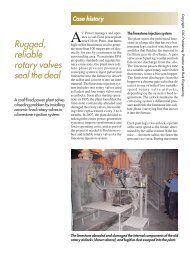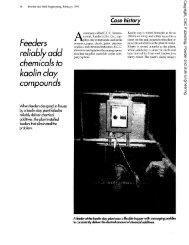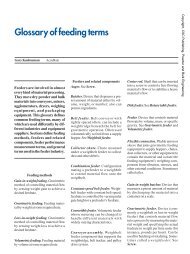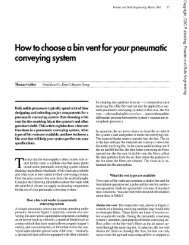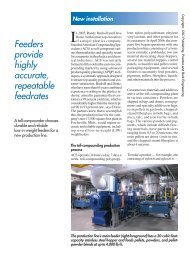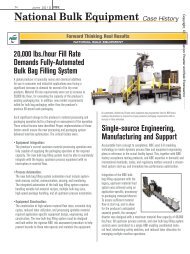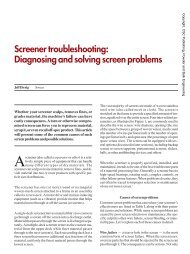Download - Powder and Bulk Engineering Magazine
Download - Powder and Bulk Engineering Magazine
Download - Powder and Bulk Engineering Magazine
You also want an ePaper? Increase the reach of your titles
YUMPU automatically turns print PDFs into web optimized ePapers that Google loves.
Automated batching for improved product<br />
quality <strong>and</strong> processing efficiency — Part II<br />
David Boger<br />
Flexicon Corp.<br />
This two-part article explains how an automated<br />
batching system can overcome the inaccuracy, limited<br />
output, <strong>and</strong> other problems associated with<br />
manual batching operations. Part I (September) explained<br />
how automated gain-in-weight <strong>and</strong> loss-inweight<br />
batching systems work, how they are<br />
applied, <strong>and</strong> what to consider when selecting a system<br />
for your application. Part II (October) concludes<br />
the article with information on selecting<br />
conveyors for an automated batching system, integrating<br />
the system with your plant equipment <strong>and</strong><br />
controls, <strong>and</strong> promoting flow of difficult materials<br />
in the system; two automated batching system case<br />
histories are also included.<br />
material it contains to weigh only the amount of material<br />
the unloader <strong>and</strong> conveyor have lost. To accomplish this,<br />
the unloader, the material it contains, <strong>and</strong> the conveyor<br />
must be weighed in their entirety, which requires supporting<br />
the conveyor from the unloader’s frame. However, the<br />
longer the mechanical conveyor, the more difficult it is to<br />
weigh the unloader <strong>and</strong> conveyor as one unit. This problem<br />
does not exist for a mechanical conveyor in a gain-inweight<br />
system, because the conveyor’s discharge end can<br />
be suspended from a ceiling joist or other overhead structure<br />
over the batch vessel.<br />
A pneumatic conveyor in a gain-in-weight system often<br />
requires a filter receiver above the process vessel <strong>and</strong> the<br />
headroom to accommodate it. In addition, the longer the<br />
pneumatic conveying line, the more in-flight material the<br />
system must compensate for.<br />
Copyright, CSC Publishing, <strong>Powder</strong> <strong>and</strong> <strong>Bulk</strong> <strong>Engineering</strong><br />
Some conveyor selection advice<br />
Choosing conveyors for your automated batching system<br />
is a complex topic that could easily be the subject of an entire<br />
article. Sometimes, your batching system requirements<br />
will influence or even dictate which conveyors you<br />
choose for the system. In other cases, your existing conveyors<br />
or preference for a particular conveyor type will<br />
govern your choice. Here are a few rules of thumb for selecting<br />
conveyors for your automated batching system.<br />
Generally, a mechanical conveyor is suitable for transporting<br />
both free- <strong>and</strong> non-free-flowing materials over relatively<br />
short distances <strong>and</strong> is appropriate for either a<br />
gain-in-weight or loss-in-weight batching system. However,<br />
in a loss-in-weight system, the load cells at each ingredient<br />
source, such as a bulk bag unloader, must account<br />
for the weight of the mechanical conveyor <strong>and</strong> the residual<br />
Integrating the automated batching system with your<br />
plant equipment <strong>and</strong> controls<br />
An automated batching system can be integrated with, or<br />
operated independently from, the plant’s bulk h<strong>and</strong>ling<br />
system or overall process.<br />
Options for controlling your automated batching system<br />
include:<br />
• A PLC dedicated to the batching system.<br />
• A sequential batch controller, which is a programmable<br />
device that can store product recipes <strong>and</strong> control the<br />
batching system.<br />
• An existing plantwide PLC integrated with a scale interface<br />
card that transmits weight data to the PLC.
• An existing plantwide PLC integrated with a sequential<br />
batch controller that can initiate the batch, download ingredient<br />
weights to the sequential batch controller, turn<br />
the batching system operation over to the sequential<br />
batch controller, <strong>and</strong>, when the batch is completed,<br />
download <strong>and</strong> store batch weight data.<br />
Automated batching case histories<br />
In the following examples, you can see how automated<br />
gain-in-weight <strong>and</strong> loss-in-weight batching systems were<br />
installed in two applications, with details about how each<br />
system was configured <strong>and</strong> the benefits it provided.<br />
Maintaining<br />
flow of<br />
difficult<br />
materials<br />
Gain-in-weight system for isotopic chemicals production.<br />
A chemical company installed an automated gain-in-weight<br />
batching system to produce a new isotopic chemical. Producing<br />
the chemical requires mixing five fine powder ingredients<br />
in batch weights ranging from less than 20 pounds (9<br />
kilograms) to nearly 400 pounds (181 kilograms) with an<br />
accuracy of ±1.00 percent for each. Four of the ingredients<br />
are received in bulk bags, <strong>and</strong> the last, a minor ingredient, is<br />
received in 50-pound (23-kilogram) bags.<br />
The gain-in-weight system includes four bulk bag unloaders<br />
for the four major ingredients, a manual bag-dump station for<br />
the minor ingredient, <strong>and</strong> five flexible screw conveyors lead-<br />
Copyright, CSC Publishing, <strong>Powder</strong> <strong>and</strong> <strong>Bulk</strong> <strong>Engineering</strong><br />
Non-free-flowing materials<br />
that pack, cake, or bridge<br />
at various points in your<br />
automated gain-in-weight or lossin-weight<br />
batching system can result<br />
in inaccurate ingredient<br />
measurements. To prevent this,<br />
your batching system must include<br />
equipment that promotes material<br />
flow throughout the system.<br />
When your automated batching<br />
system h<strong>and</strong>les materials unloaded<br />
from bulk bags, the system must<br />
maintain consistent flow from the<br />
bags. The way bulk bags are<br />
shipped <strong>and</strong> stored often packs the<br />
material, or worse, completely solidifies<br />
it, particularly in the case of<br />
certain fine powders, hygroscopic<br />
chemicals, <strong>and</strong> food products. To<br />
promote flow of packed materials,<br />
you can fit each bulk bag unloader<br />
in the system with pneumatically<br />
actuated plates that massage opposite<br />
bottom edges of the bag <strong>and</strong><br />
push material into its outlet spout.<br />
This st<strong>and</strong>-alone bulk bag conditioner has hydraulic rams for loosening<br />
packed material.<br />
You can also equip each unloader<br />
with a device that maintains constant<br />
downward tension on the<br />
bulk bag spout as the bag empties<br />
<strong>and</strong> elongates, promoting complete<br />
bag discharge without requiring<br />
manual intervention.<br />
Loosening materials that solidify in<br />
the bag can require a more extreme<br />
flow-promoting device: a bulk bag<br />
conditioner. The conditioner,<br />
which can be a st<strong>and</strong>-alone device,<br />
as shown in Figure A, or be integrated<br />
into the bulk bag unloader<br />
frame, uses hydraulic rams with<br />
contoured end plates to press opposite<br />
bag sides with high pressure at<br />
various bag heights to loosen the<br />
material <strong>and</strong> promote flow.<br />
If your gain-in-weight batching<br />
system includes a weigh hopper,<br />
you must design the hopper to discharge<br />
100 percent of the weighed<br />
batch with no residual material left<br />
in the hopper. To h<strong>and</strong>le non-freeflowing<br />
materials, make sure the<br />
hopper incorporates appropriate<br />
wall angles <strong>and</strong> flow aids, such as<br />
vibration or air fluidization devices,<br />
to promote flow <strong>and</strong> full<br />
evacuation of the batch.<br />
—D. Boger
ing from each unloader <strong>and</strong> the bag dump station to a weigh<br />
hopper mounted on load cells. Each conveyor is designed for<br />
the flow characteristics of the ingredient it h<strong>and</strong>les. The weigh<br />
hopper, as shown in Figure 1, is equipped with a slide-gate<br />
valve that discharges to a Y diverter; one diverter leg discharges<br />
to a dry blender <strong>and</strong> one to a wet blender.<br />
In operation, the gain-in-weight system’s controller activates<br />
the bulk bag unloaders to discharge a preset batch<br />
weight of two ingredients <strong>and</strong> the bag dump station to unload<br />
the minor ingredient; these ingredients are moved in<br />
sequence by the flexible screw conveyors at maximum<br />
feedrate to the weigh hopper. The load cells under the hopper<br />
transmit weight-gain information to the system’s controller,<br />
which starts <strong>and</strong> stops each conveyor <strong>and</strong> slows the<br />
feedrate to a dribble as the weight approaches the target<br />
weight, thus meeting the application’s strict accuracy requirements.<br />
The three ingredients are discharged from the<br />
weigh hopper through the slide-gate valve to the Y diverter,<br />
which diverts them to the dry blender for premixing.<br />
From there, the mixture discharges to the wet blender<br />
to be premixed with water. This process is repeated for the<br />
remaining two ingredients, which are discharged in sequence<br />
to the weigh hopper, then discharged through the<br />
slide-gate valve <strong>and</strong> routed by the Y diverter directly to the<br />
wet blender, where all the ingredients are mixed.<br />
In addition to increasing the plant’s margarine production<br />
by 50 percent, the loss-in-weight system’s automated controls<br />
minimize the risk of human error, improving the<br />
product quality. The completely enclosed system moves<br />
the salt <strong>and</strong> whey powder from bulk bag to premixer with<br />
no product contamination or fugitive dust.<br />
Figure 1<br />
Weigh hopper <strong>and</strong> flexible screw conveyors in chemical<br />
company’s gain-in-weight system<br />
Copyright, CSC Publishing, <strong>Powder</strong> <strong>and</strong> <strong>Bulk</strong> <strong>Engineering</strong><br />
The gain-in-weight system meets the company’s strict accuracy<br />
requirements for the ingredient proportions in each<br />
batch of the isotopic chemical.<br />
Loss-in-weight system for margarine production. A food<br />
products company wanted to switch from a manual batching<br />
operation to automated batching in its margarine production<br />
line to boost production <strong>and</strong> improve product<br />
quality. To make the margarine, salt <strong>and</strong> whey powder are<br />
premixed so they can be blended later with canola oil. In the<br />
manual operation, an operator dumped 33- <strong>and</strong> 44-pound<br />
(15- <strong>and</strong> 20-kilogram) bags of salt <strong>and</strong> whey powder into a<br />
premixer on an open processing floor. The manual process<br />
resulted in some dusting <strong>and</strong> bag spillage <strong>and</strong> required disposal<br />
of 100 empty bags a day. Occasionally, the ingredient<br />
quantities added to the premixer were not accurate.<br />
Figure 2<br />
<strong>Bulk</strong> bag unloaders for salt <strong>and</strong> whey powder in loss-inweight<br />
system for margarine production<br />
To overcome these problems, the company installed an automated<br />
loss-in-weight batching system for the premix ingredients,<br />
which the plant now receives in 2,200-pound<br />
(1,000-kilogram) bulk bags. The system includes two bulk<br />
bag unloaders, one for salt <strong>and</strong> one for whey powder, as<br />
shown in Figure 2. Each unloader has an integral flexible<br />
screw conveyor <strong>and</strong> is mounted on load cells linked to the system<br />
controls <strong>and</strong> from there to the plantwide control system.<br />
Below each unloader is an 8-cubic-foot (0.22-cubic-meter)<br />
stainless steel hopper; a flexible screw conveyor runs from the<br />
hopper outlet to the premixer inlet. The entire system is enclosed.<br />
In operation, each loss-in-weight bulk bag unloader<br />
delivers preset batch weights of ingredient to the premixer.
The bulk bag unloader in this loss-in-weight batching<br />
system is mounted on load cells (within the yellow<br />
guards at the base of the unloader legs), allowing it<br />
to discharge precise amounts of powder to a screw<br />
conveyor that feeds three ribbon blenders.<br />
Copyright, CSC Publishing, <strong>Powder</strong> <strong>and</strong> <strong>Bulk</strong> <strong>Engineering</strong><br />
Weighing your options<br />
Thanks to the wide range of potential system configurations<br />
<strong>and</strong> available batching components, you can select<br />
an automated batching system that functions reliably in<br />
your application, improves product quality, <strong>and</strong> boosts<br />
product output while cutting production costs.<br />
For best results, work closely with your batching system<br />
supplier. Choosing a supplier that offers both mechanical<br />
<strong>and</strong> pneumatic conveyors <strong>and</strong> a full range of other system<br />
components, including controls, will help ensure that your<br />
system is customized to h<strong>and</strong>le your application. Witnessing<br />
tests of your batching system at the supplier’s facility<br />
is also an important part of the selection process, <strong>and</strong> tests<br />
on full-scale equipment will provide the most reliable<br />
proof that the system will work as designed with the accuracy<br />
you require.<br />
PBE<br />
For further reading<br />
Find more information on automated batching in articles<br />
listed under “Weighing <strong>and</strong> batching” in <strong>Powder</strong> <strong>and</strong> <strong>Bulk</strong><br />
<strong>Engineering</strong>’s comprehensive article index at www.pow<br />
derbulk.com <strong>and</strong> in the December 2006 issue.<br />
David Boger is sales manager at Flexicon Corp., 2400<br />
Emrick Boulevard, Bethlehem, PA 18020; 610-814-2400,<br />
fax 610-814-0600 (dboger@flexicon.com). He holds a BS<br />
in chemical engineering from Rensselaer Polytechnic Institute<br />
in Troy, N.Y.


